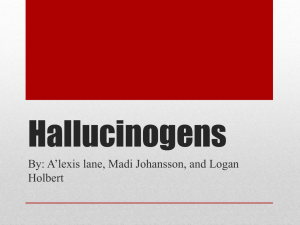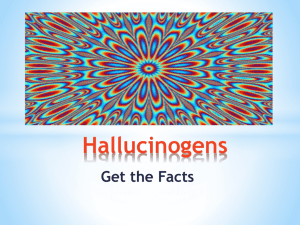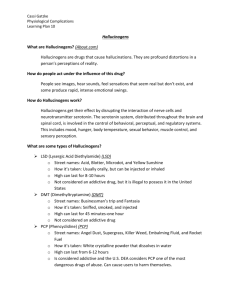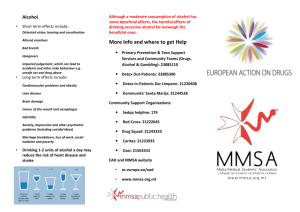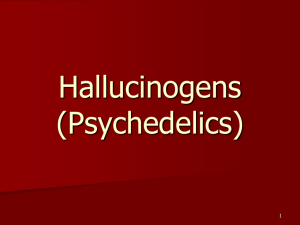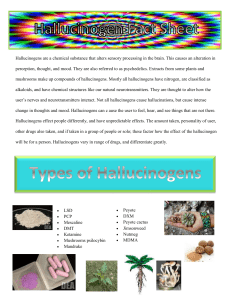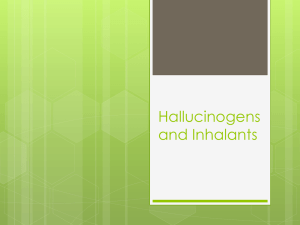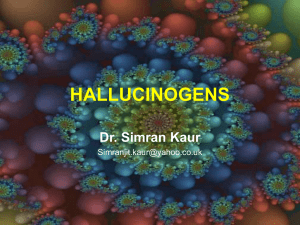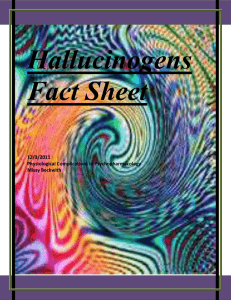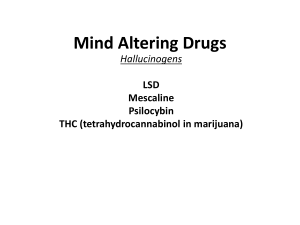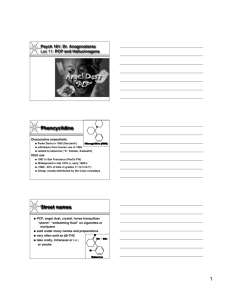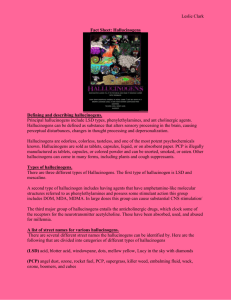Hallucinogens
advertisement
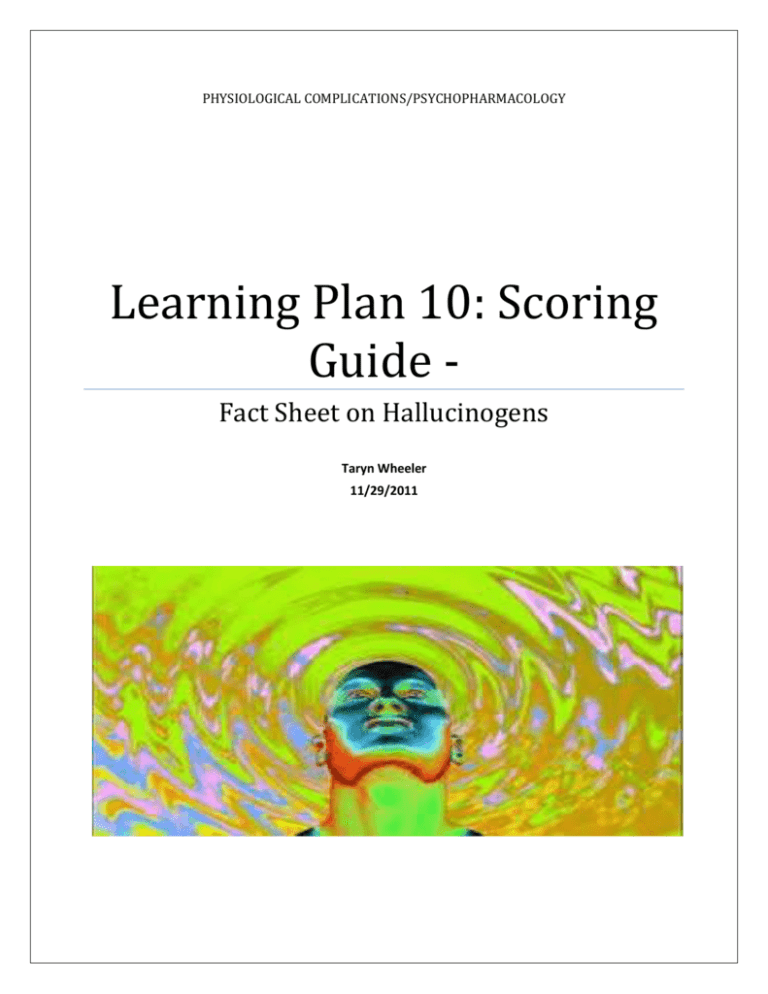
PHYSIOLOGICAL COMPLICATIONS/PSYCHOPHARMACOLOGY Learning Plan 10: Scoring Guide Fact Sheet on Hallucinogens Taryn Wheeler 11/29/2011 Fact Sheet on Hallucinogens Hallucinogens -are a chemically diverse group of drugs that cause changes in a person’s thought processes, perceptions of the physical world, and sense of time passing. Hallucinogens can be found naturally in some plants, and can be synthesized in the laboratory. Most hallucinogens are abused as recreational drugs. Hallucinogens are also called psychedelic drugs. Under the influence of hallucinogens, people see images, hear sounds, and feel sensations that seem real but do not exist. Some hallucinogens also produce rapid, intense emotional swings. Hallucinogens cause their effects by disrupting the interaction of nerve cells and the neurotransmitter serotonin. Disrupted throughout the brain and spinal cord, the serotonin system is involved in the control of behavioral, perceptual, and regulatory systems, including mood, hunger, body temperature, sexual behavior, muscle control, and sensory perception. Types of LSD – (d-lysergic acid diethylamide) is one of the most common, most potent mood-changing chemicals. It was discovered in 1938 and is manufactured from lysergic acid, which is found in ergot, a fungus that grows on rye and other grains. Peyote – is a small, spineless cactus in which the principal active ingredient is mescaline. This plant has been used by natives in northern Mexico and the southwestern United States as part of religious ceremonies. Mescaline can also be produced through chemical synthesis. Psilocybin – Mushrooms containing psilocybin are available fresh or dried and are typically taken orally. Psilocybin and its biologically active form, psilocin, cannot be inactivated by cooking or freezing preparations. Thus, they may also be brewed as a tea or added to other foods to mask their bitter flavor. The effects of psilocybin, which appear within 20 minutes of ingestion, last approximately 6 hours. PCP – Is a white crystalline powder that is readily soluble in water or alcohol. It has a distinctive bitter chemical taste. PCP can be mixed easily with dyes and is often 2|Page Fact Sheet on Hallucinogens sold on the illicit drug market in a variety of tablet, capsule, and colored powder forms that are normally snorted, smoked, or orally ingested. For smoking, PCP is often applied to a leafy material such as mint, parsley, oregano, or marijuana. Depending upon how much and by what route PCP is taken, its effects can last approximately 4-6 hours. For various Hallucinogens Marijuana Hashish Mescaline and Peyote LSD Pot, Reefer, Grass, Weed, Dope, Ganja, Mary Jane, Sinsemiia, Urb Hash Mesc, Buttons, Cactus Acid, Microdot, White lightning, Blue heaven, Sugar cubes, Battery Acid, Blotter, Boomers, California Sunshine, Cid, Doses, Dots, Golden Dragon, Hippie, Loony toons, Lucy in the sky with diamonds, Pane, Purple Heart, Superman MDMA (Ecstasy) E, XTC, vitamin E, candy, mind candy, nikEs, blue nikEs, yellow bannans, mitubishis, 007’s, double stacks (Combination of LSD and Ecstasy is referred to “Candy Flipping” Combination of Ecstasy and Mushrooms is referred to “Hippie Flipping” Psilocybin Magic Mushrooms, shrooms Phencyclidine PCP, Hog, Angel Dust, Loveboat, Lovely 3|Page Fact Sheet on Hallucinogens How do Hallucinogens Affect the Brain? LSD, peyote, psilocybin, and PCP are drugs that cause hallucinations, which are profound distortions in a person’s perception of reality. Under the influence of hallucinogens, people see images, hear sounds, and feel sensations that seem real but are not. Some hallucinogens also produce rapid, intense emotional swings. LSD, peyote, and psilocybin cause their effects by initially disrupting the interaction of nerve cells and the neurotransmitter serotonin. Disrupted throughout the brain and spinal cord, the serotonin system is involved in the control of behavioral, perceptual, and regulatory systems, including mood, hunger, body temperature, sexual behavior, muscle control, and sensory perception. On the other hand, PCP acts mainly through a type of glutamate receptor in the brain that is important for the perception of pain, responses to the environment, and learning and memory. Physiological Effects Increased blood pressure and heart rate Increased body temperature Dizziness Sweating Nausea Dry mouth Numbness Tremors Loss of Appetite Psychedelic Effects 4|Page Fact Sheet on Hallucinogens Depersonalization, dreamlessness Sensory distortion Altered mood Impaired concentration and motivation Loss of judgment, slowed reaction time Illusion: mistaken perception of real stimuli Delusion: irrational thinking Confusion Dissociative reactions Acute panic Flash backs Acute anxiety Fear over loss of control Paranoia Delusions leading to self-destructive behaviors Of LSD, Mushrooms, PCPM and Mescaline Dilated pupils Dizziness Dry mouth Numbness Tremors Heavy perspiration Bad body odor Chills “Goose bumps” Nausea Muscle weakness Trembling Poor coordination 5|Page Fact Sheet on Hallucinogens Lowered body temperature (LSD or psilocybin mushrooms) Higher body temperature (peyote/mescaline) Rapid heart rate (LSD or psilocybin mushrooms) Depressed heart rate and breathing (peyote/mescaline High blood pressure (LSD or psilocybin mushrooms) Lowered blood pressure (peyote/mescaline) Seizures (LSD or psilocybin mushrooms) Of LSD, Mushrooms, PCP and Mescaline Psychological dependence Cross-tolerance – the need for increasing amounts to feel effects; covers various substances, not just those someone has used Depression Anxiety Increased risk of developing schizophrenia or psychotic episodes Miscarriages Birth defects Fatal liver damage if the wrong mushroom is ingested Flashbacks Hallucinogen Persisting Perception Disorder (HPPD) – trailing images, spots, auras, and other visual disturbances; depression, or panic attacks; long after use or perhaps permanent Memory loss Difficulty speaking Unwanted weight loss Recognizing signs of drug use and dependence The particular signs and symptoms of drug use and dependence vary depending on the type of drug. You might be able to tell that a family member or a friend is using or abusing a drug based on the physical and behavioral signs and symptoms associated with the drug. 6|Page Fact Sheet on Hallucinogens Drug addiction symptoms and behaviors include: Feeling that you have to use the drug regularly- this can be daily or even several times a day Failing in your attempts to stop using the drug Making certain that you maintain a supply of the drug Spending money on the drug, even though you can’t afford it Doing things to obtain the drug that you normally wouldn’t do, such as stealing Feeling that you need the drug to deal with your problems Driving or doing other risky activities when you’re under the influence of the drug Focusing more and more time and energy on getting and using the drug It can sometimes be difficult to distinguish normal teenage moodiness or anger from signs of drug use. Possible indications that a teenager is using drugs include: Problems at school- Frequently missing classes or missing school, a sudden disinterest in school or school activities, or a drop in grades may be indicators of drug use. Physical health issues- Lack of energy and motivation may indicate your child is using certain drugs. Neglected appearance- Teenagers are generally concerned about how they look. A lack of interest in clothing, grooming or looks may be a warning sign of drug use. Changes in behavior- Teenagers enjoy privacy, but exaggerated efforts to bar family members from entering their rooms or knowing where they go with their friends might indicate drug use. Also, drastic changes in behavior and in relationships with family and friends may be linked to drug use. Spending money- Sudden requests for money without a reasonable explanation for its use may be a sign of drug use. You may also discover money stolen from previously safe places at home. Items may disappear from your home because they’re being sold to support a drug habit. o Effects of withdrawal from hallucinogens have not been clearly established because these drugs do not seem to be physically addictive. They may, however, be psychologically addictive because users feel emotionally dependent on taking them. 7|Page Fact Sheet on Hallucinogens Works Cited http://deoxy.org/psyguide.htm http://drugabuse.gov/infofacts/hallucinogens.html www.drugfree.org/drug-guide/lsd http://www.egetgoing.com/drug_rehab/hallucinogens.asp www.freemd.com/drugabuse/symptoms-hallucinogens.htm http://www.intheknowzone.com/halluc/health.htm http://mayoclinic.com/health/drug-addiction/DS00183/DS 8|Page
